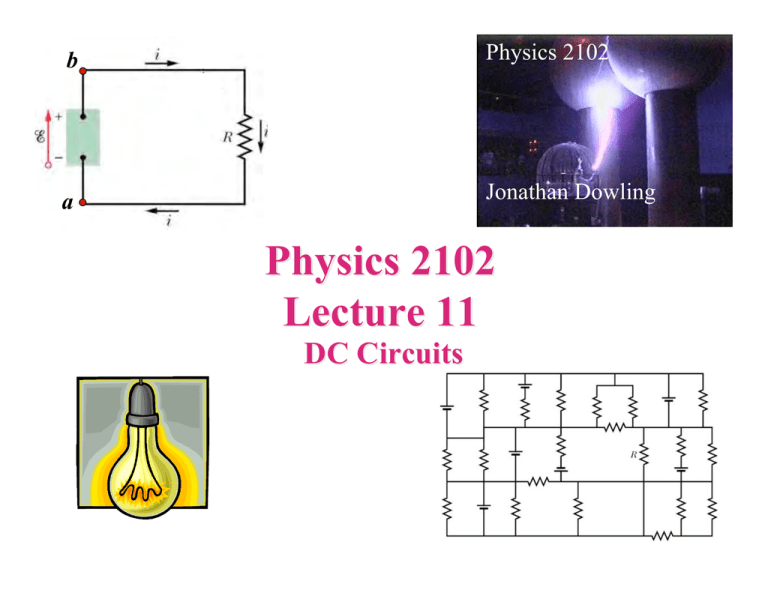Physics 2102 Lecture 11 DC Circuits
advertisement

b Physics 2102 a Jonathan Dowling Physics 2102 Lecture 11 DC Circuits Incandescent light bulbs (a) (b) (c) (d) (e) (f) Which light bulb has a smaller resistance: a 60W, or a 100W one? Is the resistance of a light bulb different when it is on and off? Which light bulb has a larger current through its filament: a 60W one, or a 100 W one? Would a light bulb be any brighter if used in Europe, using 240 V outlets? Would a US light bulb used in Europe last more or less time? Why do light bulbs mostly burn out when switched on? EMF devices and single loop circuits b The battery operates as a “pump” that moves positive charges from lower to higher electric potential. A battery is an example of an “electromotive force” (EMF) device. a These come in various kinds, and all transform one source of energy into electrical energy. A battery uses chemical energy, a generator mechanical energy, a solar cell energy from light, etc. i − + d b c The difference in potential energy that the a device establishes is called the EMF i and denoted by Ε. Ε = iR iR Ε Va a b c d=a Circuit problems Given the emf devices and resistors in a circuit, we want to calculate the circulating currents. Circuit solving consists in “taking a walk” along the wires. As one “walks” through the circuit (in any direction) one needs to follow two rules: When walking through an EMF, add +E if you flow with the current or −E otherwise. How to remember: current “gains” potential in a battery. When walking through a resistor, add -iR, if flowing with the current or +iR otherwise. How to remember: resistors are passive, current flows “potential down”. Example: Walking clockwise from a: + E-iR=0. Walking counter-clockwise from a: − E+iR=0. Ideal batteries vs. real batteries If one connects resistors of lower and lower value of R to get higher and higher currents, eventually a real battery fails to establish the potential difference Ε, and settles for a lower value. One can represent a “real EMF device” as an ideal one attached to a resistor, called “internal resistance” of the EMF device: E –i r − i R=0 → i=E/(r+R) Etrue = E –i r The true EMF is a function of current: the more current we want, the smaller Etrue we get. Resistors in series and parallel An electrical cable consists of 100 strands of fine wire, each having 2 Ω resistance. The same potential difference is applied between the ends of all the strands and results in a total current of 5 A. (a) (b) (c) What is the current in each strand? Ans: 0.05 A What is the applied potential difference? Ans: 0.1 V What is the resistance of the cable? Ans: 0.02 Ω Assume now that the same 2 Ω strands in the cable are tied in series, one after the other, and the 100 times longer cable connected to the same 0.1 Volts potential difference as before. (d) What is the potential difference through each strand? Ans: 0.001 V (e) What is the current in each strand? Ans: 0.0005 A … (f) What is the resistance of the cable? Ans: 200 Ω (g) Which cable gets hotter, the one with strands in parallel or the one with strands in series? Ans: each strand in parallel dissipates 5mW (and the cable dissipates 500 mW); each strand in series dissipates 50 µW (and the cable dissipates 5mW) DC circuits: resistances in series Two resistors are “in series” if they are connected such that the same current flows in both. The “equivalent resistance” is a single imaginary resistor that can replace the resistances in series. In the circuit with the equivalent resistance, “Walking the loop” results in : E –iReq=0 → i=E/Req E –iR1-iR2-iR3=0 → i=E/(R1+R2+R3) Thus, n Req = ! R j j =1 Multiloop circuits: resistors in parallel Two resistors are “in parallel” if they are connected such that there is the same potential drop through both. The “equivalent resistance” is a single imaginary resistor that can replace the resistances in parallel. “Walking the loops” results in : E –i1R1=0, E –i2R2=0, E –i3R3=0 The total current delivered by the battery is i = i1+i2+i3 = E/R1+ E/R2+ E/R3. In the circuit with the equivalent resistor, i=E/Req. Thus, n 1 1 =! Req j =1 R j Resistors and Capacitors Resistors Key formula: V=iR In series: same current Req=∑Rj In parallel: same voltage 1/Req= ∑1/Rj Capacitors Q=CV same charge 1/Ceq= ∑1/Cj same voltage Ceq=∑Cj Example Bottom loop: (all else is irrelevant) 12V 8Ω i= V 12V = = 1.5 A R 8! Which resistor gets hotter? Example a) Which circuit has the largest equivalent resistance? b) Assuming that all resistors are the same, which one dissipates more power? c) Which resistor has the smallest potential difference across it? Example Find the equivalent resistance between points (a) F and H and (b) F and G. (Hint: For each pair of points, imagine that a battery is connected across the pair.) Monster Mazes If all resistors have a resistance of 4Ω, and all batteries are ideal and have an emf of 4V, what is the current through R? If all capacitors have a capacitance of 6µF, and all batteries are ideal and have an emf of 10V, what is the charge on capacitor C?







